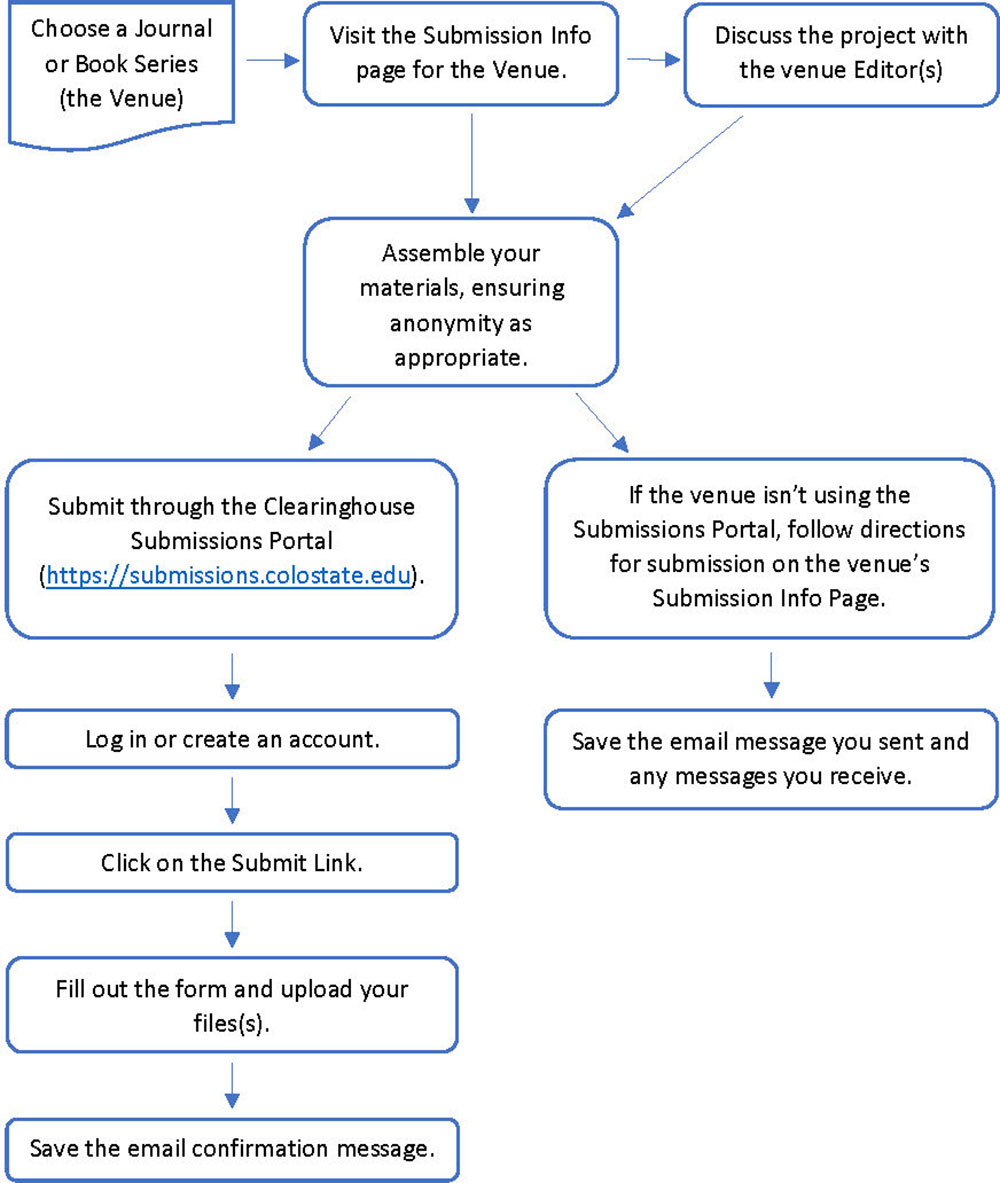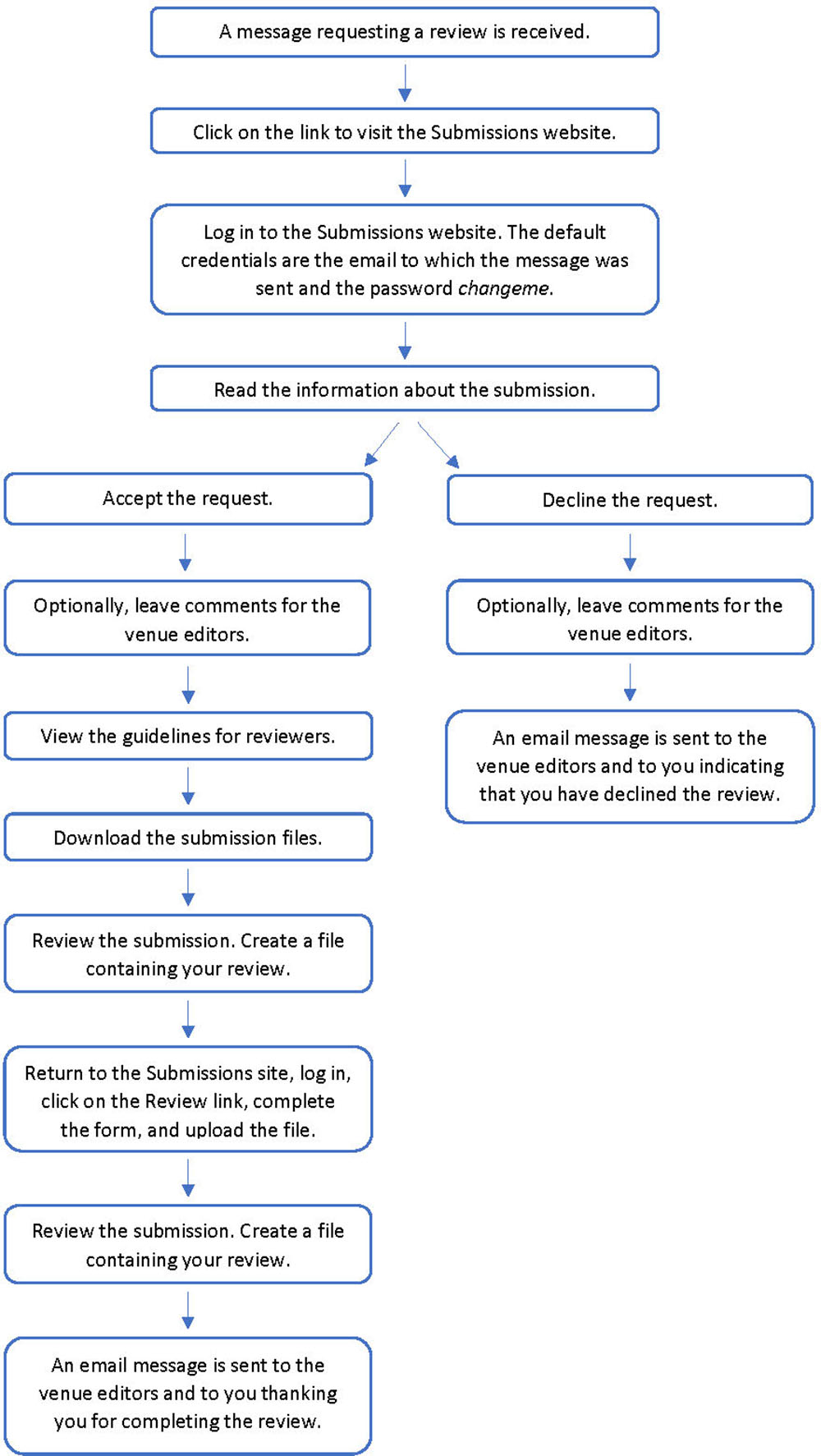Section 4. Publication Processes for Books
4.1 Submission Process
Submissions to a book series can involve a proposal for a new book or submission of a full manuscript. All submissions should occur through the Clearinghouse submissions portal (https://submissions.wacclearinghouse.org). In the event that a submission is made through email or another form of personal communication and the submission is deemed worthy of further consideration, the book author or editor should be directed to submit the proposal or manuscript through the submissions portal.
The series editors will not consider work submitted simultaneously for consideration by another publisher. The basic process for submitting to a journal is found in Figure 1.

Figure 1. An Overview of the Process for Submitting to a Clearinghouse Journal, Book Series, or Edited Collection
4.2 Review Process
If the series editors determine that a proposal is consistent with the goals of the series and possesses strong scholarly merit, it will undergo a rigorous peer review by scholars selected by the series editorial team. Reviews should conform to the WAC Clearinghouse peer review processes. These processes are informed by the Clearinghouse invitation to contribute scholarly work and its statement on publication ethics.
Reviews will be conducted by reviewers associated with the series as editorial review board members and, in some cases, by members of the Clearinghouse editorial board. Reviews are typically completed in one or two months. The submissions portal provides tools that allow members of a series editorial team to manage submissions, to provide access to reviewers, to request and manage reviews, and to identify members of an editorial review board. You can view information about using the portal in Section 6. An overview of the review process is found in Figure 2.

Figure 2. An Overview of the Process for Reviewing a Submission to a Clearinghouse Journal, Book Series, or Edited Collection
4.3 Issuing Contracts
When the review process is complete and the editorial team has determined that a contract should be issued, they should contact the publisher with a request to issue a contract. Normally, the decision to offer a contact for a book is made following review of a book proposal. However, if a manuscript is submitted in place of a proposal, the decision to issue a contract can be made following review of the full manuscript. This review might lead to a request to revise and resubmit, to accept the book as is for publishing, or to reject the book. In all cases, the decision to publish a book will be based on review of the final manuscript. That is, while a contract indicates that the book will be considered for publication, the final decision is based on the quality of the final manuscript.
Issuing a contract involves the following steps.
- The editorial team sends to the publisher (a) the book proposal and supporting materials (sample chapters, author/editor CVs) or the complete manuscript and supporting materials; (b) the reviews completed for the book; and (c) any comments regarding the book, the likely manuscript turnover date, and unusual formatting or production concerns.
- The publisher reviews the materials and, typically, agrees to issue the contract.
- The publisher creates the contract and, working in Adobe Sign, distributes it to the series editorial team and the book author(s) or editor(s).
- The publisher sends a follow-up email message indicating that the contract has been issued and explaining what to do if it’s caught in a spam filter. The message also includes a request to complete two forms: (a) the CIP data form, which is used to prepare the submission of the book to the Library of Congress; and (b) the Clearinghouse marketing information form, which is used for marketing and to prepare the book cover and website material. These documents can be found in the Appendix.
- When the contract is signed by all parties, it is distributed automatically as a PDF document to everyone who signed it.
4.4 Development Process
The Clearinghouse encourages a review process based on anonymous review of proposals and manuscripts and clear advice regarding improvements to a manuscript. We emphasize the creation of a constructive review environment. We focus on helping contributors develop strong proposals and manuscripts. We also encourage, in edited collections, the creation of coherence and connection across chapters. (Anyone considering developing an edited collection is encouraged to view Editing a Collection: Some Advice. Overall, we seek to help contributors create a strong contribution to central contributions within the discipline of writing studies. An overview of the development process can be found in Figure 3.

Figure 3. An Overview of the Development Process for a Book
Note: Book series editors are encouraged to consult the guide Developing Manuscripts and Moving Them into Production, which is available in the Appendix. All manuscripts submitted for publication should meet the criteria addressed in the guide.
4.5 Manuscript Preparation
Book series editors are responsible for ensuring that a manuscript is ready for publication. This includes ensuring that the manuscript meets the criteria specified in the WAC Clearinghouse Manuscript Preparation Checklist and the WAC Clearinghouse Authors and Editors Guide. These include:
- Ethical Practices. This includes attention to the WAC Clearinghouse statement on Publication Ethics and securing written permission for the use of all copyrighted work and student writing. See the Permissions section in the Guide.
- Manuscript Length. The manuscript should not exceed the length limitations for Clearinghouse books (typically, between 70,000 and 110,000 words, and not more than 125,000 words). See Manuscript Length in the Guide.
- File format. The manuscript should be provided in a single file in Word format (.docx) or “Rich Text Format” (RTF). See File Format and Delivery in the Guide.
- Content and Order. The parts of the book should our guidelines. See Book or Chapter Content and Order in the Guide.
- Author Affiliations. In edited collections and in book parts that have authors, authors' institutional affiliation should be provided.
- Abstracts, Chapter Numbers, Keywords, and Other Elements. Ensure that elements such as abstracts and keywords, particularly in edited collections, follow the series conventions. Similarly, chapter titles should use the standard approach followed by the series.
- Use of Word-Processing Styles. Manuscripts should use word processing styles (e.g., normal, heading 1, heading 2, heading 3). See Manuscript Preparation and Use of Word-Processing Styles in the Guide.
- Documentation Systems. Ensure that the manuscript follows the citation system defined in the most recent version of the MLA or APA handbook (aside from specific deviations defined in our house style). See Citation System and House Style in the Guide.
- DOIs. DOIs should be provided in reference lists and works cited lists when available. See Reference List and Works Cited List in the Guide.
- Links. Ensure that all links (websites, etc.) in the manuscript are live. Readers should be able to navigate to the sites by clicking on the link.
- Use of House Style. Our house style in some cases overrides MLA and APA guidelines. See House Style in the Guide.
- Figures, Images, and Other Illustrations. Most images should be provided as separate files in high-resolution format (e.g., at least 2400 pixel widths) for images that are intended to run the full width of a page. Some figures, such as charts and diagrams built with tools within a word processing program, can be left in the text. See Figures, Images, and Other Illustrations in the Guide.
- ALT Tags for Figures and Images. ALT tags should be provided for each figure or image. See Figures, Images, and Other Illustrations in the Guide.
- Figure Captions. Figure caption should be placed below the figure. Figure numbering should follow series guidelines (typically Chapter Number.Figure Number – e.g., Figure 3.1, Figure 5.3, etc.). See Figures, Images, and Other Illustrations in the Guide.
- Tables. Ensure that tables will reproduce well in a 5-inch width. See Tables See Figures, Images, and Other Illustrations in the Guide.
- Table Titles. Table titles should be placed above the table. Table numbering should follow series guidelines (typically Chapter Number.Table Number – Table 1.2, Table 3.3, etc.). See Tables in the Guide.
- Indexes. The WAC Clearinghouse does not provide indexing services. The production team will, however, work with authors and editors who whish to create one. Indexing must be completed before final turnover of the document, either before or after copyediting but prior to book design. See Indexing in the Guide.
- Proofreading. Ensure that the manuscript has been proofread carefully before sending it to the production team. See Proofreading in the Guide.
Note on Google Docs: Some book editors and authors prefer to use Google Docs. This can pose challenges at the later stages of manuscript preparation. For example, if a manuscript has been moved into Microsoft Word (which the production team uses to prepare a manuscript for importing into InDesign), it may have been styled (headings, etc.). If so, and the manuscript is then moved back into Google Docs, any custom styles will be lost. The production team has determined that it is best to avoid moving the document into Google Docs during the latter stages of manuscript preparation.
4.6 Production
Production involves
- preparing the manuscript for copy editing
- carrying out copy editing
- reviewing the copyedited manuscript before returning it to the book authors or editors
- working with the book authors or editors on finalizing the manuscript, including obtaining final edits and approvals from authors of chapters in an edited collection
- preparing the final manuscript for import into InDesign, which includes updating the manuscript so that it uses our standard set of styles
- working with figures
- ensuring that ALT tags are provided for figures and other images in the book
- ensuring that the document is structured (i.e., uses heading levels)
- creating and reviewing proofs
- designing the book cover and creating back-cover copy
- creating the book webpage
- creating the ePub edition
- sharing the print files with our print publishing partner
Additional work involves submitting the book to the Library of Congress, assigning and registering ISBN numbers, registering the book with OCLC WorldCat, and creating and registering the book DOI.
Detailed information about the production process can be found in the Appendix.
4.7 Dissemination / Marketing
When a book is ready for release in digital editions, announcements are sent to major email lists (typically WAC-L, WCenter, WritingStudies-L, and the Clearinghouse list WACNews-L). If the content of the book is relevant, it is also sent to EATAW’s email list. Ideally, the announcement will make its way to other lists, such as the TYCA list.
The book is also announced on social media through the Clearinghouse Facebook, LinkedIn, and Twitter accounts.
The book may also be announced on the Clearinghouse main page.
When the print edition is ready, our print publishing partner announces the book to a marketing list it has created, makes it available in marketplaces such as Amazon, and engages in other marketing efforts as appropriate.